#Indo-Russian
Explore tagged Tumblr posts
Text

English is part of a large language family that includes French, Welsh, Polish, Persian, Greek, and Albanian. They stem from a common ancestor reconstructed as Proto-Indo-European. The cardinal numerals from 1 to 10 illustrate their relationship well. Click the image for a selection.
#historical linguistics#linguistics#language#etymology#english#latin#french#german#spanish#welsh#irish#sanskrit#persian#polish#russian#italian#gothic#proto-germanic#proto-celtic#proto-indo-iranian#proto-balto-slavic#lithuanian#ancient greek#albanian#icelandic
101 notes
·
View notes
Text

Sun Goddess Tapestry (the sun maiden’s journey): A Breakdown of Motifs
The top two panels represent the sun goddess in the day time and summer half of the year.

The Fire Symbol:

From Goddess Embroideries of Eastern Europe by Mary B. Kelly, 1996 (personal library)

Bird motif
“Because the soul was supposed to fly to heaven, birds represented the soul of the dead person. Ritual towels, embroidered with birds symbolizing the ancestors were hung from an upstairs window to attract to the soul to return home. These towels are sometimes embroidered with the symbols of the grave marker as well.”
From Goddess Embroideries of Eastern Europe by Mary B. Kelly, 1996 (personal library)
In the upper panel the bird symbolizes the living soul and is surrounded by sun bursts and the sown field motif (nestled between tail and wing).

From: When They Severed Earth From Sky: How the Human Mind Shapes Myth by Elizabeth Wayland Barber (personal library).

Sun Chariot
During her journey through the day time sky the sun maiden drives a chariot pulled by horses:
This article is a great read on the sun chariot and sun boat/shallop in Northern Russian embroidery.
I have framed the sun chariot on either side with sun trees and sun flowers.

Solar Wheel motif
I used this motif to divide the panels showing the sun goddess in her day time/summer time aspects and night time/winter aspects.
The solar wheel is surrounded by highly stylized goddess figures that have morphed into the tree of life.


From Goddess Embroideries of Eastern Europe by Mary B. Kelly, 1996 (personal library)

Sun shallop motif (in red):
I chose this motif to represent the sun at night and during the winter half of the year.
At night the sun goddess travels the underworld in a boat (shallop) pulled by swans. See the sun chariot motif above for a link to traditional Russian costume’s article on the sun chariot and the sun shallop in northern Russian embroidery.
Grave marker motif (in blue):
I chose the grave marker border to symbolize the sun goddesses journey through the underworld.
“Another spring rite known throughout Russia is the “day of Memory”. Celebrated around Easter time in early spring, it is the day for remembering the dead and the ancestors. Women cut branches to cover the graves, particularly the graves of their mothers. Spring embroideries depicting women holding branches in their hands were then tied to the grave markers. These markers have a very ancient peaked-roof motif which appears in the embroideries as well. Research shows these graves to be at least a 1000 years old; they have survived in just this form into the present day. The grave markers provide another example of a motif whose survival, like the goddess motif, comes down to our day from pagan times. Originally in the pagan religion the dead were cremated and the ashes of the dead were placed in a small ceramic jar on a shelf, protected by the overhanging roof.”
From Goddess Embroideries of Eastern Europe by Mary B. Kelly, 1996 (personal library)
Bird motif (in blue):
The birds here in the lower panel symbolize the souls of the ancestors.
#folk embroidery#russian#slavic#Karelia#sun goddess#saule#sunna#solntse#indo european#sun chariot#sun shallop#Solar wheel#goddess#sun#solar#sun goddess tapestry
27 notes
·
View notes
Text
Words you didn’t know are related: gold, yellow, cholera, arsenic, yolk, and more!
The Proto-Indo-European language (the hypothesized original ancestor language of most modern languages in Europe and South Asia, hereafter abbreviated “PIE”) had a root *ǵʰelh₃- ‘yellow, green’. Aside: How can this word refer to both ‘yellow’ and ‘green’? Historically, color terms in the world’s languages referred to a broader range of colors than they do today, and focused more on the texture…
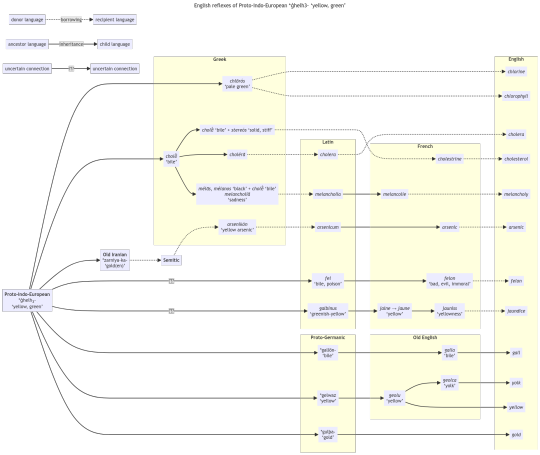
View On WordPress
#English#etymology#French#Greek#historical linguistics#historical reconstruction#Indo-European#Iranian#Latin#Latvian#Old English#Proto-Indo-European#Russian#Semitic#Slavic
52 notes
·
View notes
Text
Conjunctions in languages
A linguistic digression:
The "eh" and "ee" sounds stand for "and" in many European languages. After that, most European languages use a variation of "oh" or "ah" sounds to stand for "and"; or "un" or "und" sounds if they're Germanic.
Languages and linguistics is another hobby of mine that I'm still learning about, but I've already noticed this pattern of "eh" or "ee" for many European languages.
It's spelled "et" in French, but the t is silent in pronunciation. Spanish spells "y" but it's pronounced "ee". In Russian, "and" is transliterated into English with a capital I from the original character- which resembles a reversed or upside-down capital N from the English alphabet- but is pronounced "ee" here too.
Latin's "et" has the silent t like French- it's pronounced "eh" which is similar to the French pronunciation, which sounds more like "eeh".
I don't believe learning a second or more languages is as hard as some academics want everyone to believe- it's really just about noticing patterns like this "eh/ee" sound and other sounds being used across different languages, and then just taking the time to commit it to memory. If you practice reading slowly for about 20 minutes or more 5 days a week, you'd probably get the basics of a language within a few months.
I lost the book, but a linguistics book I read talked about how most languages descended from the original Proto-Indo-European (PIE) language share similarities. Almost all modern European languages are descended from PIE, which helps explain why most of them would have similarities to each other.
This book also talked about how memorizing conjunctions like "and" across different European languages is like a cheat code for learning multiple languages, at least ones derived from PIE. Even if you don't know many words, if you learn the conjunctions that many European languages share, then you should get to the point where you can read any of these languages and get the basic gist of what's being said. After memorizing conjunctions, you slowly build on that foundation with individual words that are unique to each language.
The words "god" and "deity" and "zeus" are all ultimately derived from PIE- English, German, Greek, Latin, French, Spanish, and even Russian all have a common ancestor (so to speak). The original PIE word for a god is something like "d'ues" or "deus", like Zeus, but with a D instead of a Z sound at the start.
And even though Ancient Sumerian is an isolated language, and thought to have no connection with PIE, I have a hard time believing these two languages, which existed at roughly the same time period, had absolutely no influence on one or the other.
Sumerians used "gah" for "and", which kind of reminds me of the "jah" in Finnish (pronounced "yah"). This is not proof that there's a connection between Sumerian and prehistoric European languages- but it might imply there's something to Noam Chomsky's theories of Universal Language, even if his particular ideas ultimately missed the mark.
I need to do more research...
End of digression.
#jayjuno#juno#jay juno#artist#alaska#philosophy#philosopher#language#languages#linguistics#linguist#pie#proto indo european#and#conjunction#grammar#english#german#french#russian#writer#digression#thoughts#history#prehistory#sumerian#ancient#proto#european
5 notes
·
View notes
Text
I was just doing Anki and came across связь (rus; connection, relation) and was like wait that's awfully close to svaz (ces; union) and even has a similar meaning and lo and behold, связь, svaz and союз* all go back to the same proto indo european root, *h₂enǵʰ-. связь and svaz even share the same proto slavic root, *vę̄zàti.
*looked up союз too bc svaz means союз and i once again went wait that's also kinda close
17 notes
·
View notes
Text

tomorrow is her birthday, we just had a year timeskip, and i think it's time for some outfits :U
#my art#art#digital art#dnd#dungeons and dragons#original character#rusalka topielic#also i have a bunch of rusalka posts queued for tomorrow sors in advance#she's my babygirl#im sorry in advance if there's any eastern europeans or indo russians here bc i tried to take insp from that clothing#for her right hand outfit#and uh i think i kinda failed
2 notes
·
View notes
Text
This pattern holds across many of the conventional wars since World War II: a conflict over territory and power balance that began with the declaration of those modern states and that has flared intermittently ever since.
Armenia and Azerbaijan, for instance, two countries that also emerged out of the Soviet Union’s breakup, have fought periodic wars ever since, broken by long but tense cease-fires. India and Pakistan fought their first war within months of their independence and partition in 1947, followed by three more wars, most recently in 1999, and repeated lower-level conflicts now held at a tentative nuclear peace. North and South Korea reached an armistice in 1953 but remain in a technical state of war with occasional flare-ups and an ever-present threat of all-out fighting.
Such conflicts, in other words, have often persisted for as many as six or seven decades. With peace talks minimal or nonexistent in many cases, some may well continue longer than that.
And while outright fighting may be infrequent, with what Dr. Radchenko termed “active phases” lasting only a few months, periods of calm typically require deep international involvement to maintain. American troops, for instance, have been garrisoned in South Korea for more than 70 years.
It is impossible to predict whether this represents the future for Russia and Ukraine, though it perhaps already describes their present state. The seven years before Russia’s 2022 invasion were marked by lower-level fighting, with heavy Western diplomacy and support to Ukraine aimed at forestalling wider conflict.
This pattern shows that one side rarely vanquishes the other outright, especially with foreign states ready to step in. And it offers another lesson: Political change within those countries rarely provides the sort of breakthrough that observers are hoping might one day lead Moscow to pull back. The decade-long Soviet invasion of Afghanistan, for instance, only deepened with the elevation, in 1985, of the reform-minded leader Mikhail Gorbachev.
— What 70 Years of War Can Tell Us About the Russia-Ukraine Conflict
#max fisher#what 70 years of war can tell us about the russia-ukraine conflict#current events#history#military history#warfare#philosophy#philosophy of war#politics#international relations#russo-ukrainian war#2022 russian invasion of ukraine#nagorno-karabakh conflict#partition of india#indo-pakistani war of 1947-1948#kargil war#korean war#korean armistice agreement#russia#ukraine#sergey radchenko
2 notes
·
View notes
Text
“The West’s Hypocrisy Has Become Almost Unbearable” - Former Indian Foreign Secretary on Ukraine War, India’s Position
On December 17, Lieutenant General Igor Kirillov, a senior general in charge of Russia’s nuclear defence forces, was assassinated in Moscow along with an associate. Ukraine’s security service has claimed responsibility, and an Uzbek man has been arrested. What does this mean for the Russia-Ukraine war as it approaches its third year? And how might Donald Trump’s potential presidency affect the…

View On WordPress
#Black Sea politics#BRICS expansion#diplomatic analysis#Donald Trump#european security#former Foreign Secretary and India’s Ambassador to Moscow Kanwal Sibal#global politics#Indo-Russian relations#international relations#Kanwal Sibal interview#Moscow-Kiev conflict#nato expansion#Putin strategy#Role of US UK France NATO#Russia Ukraine War#Russian general Kirillov assassination#terror attack#Trump Russia policy#West’s hypocrisy#Western sanctions
0 notes
Text
Geopolitical Follies: A Tongue-in-Cheek Tour of Today's Global Dramas
In a world where the bizarre often trumps the mundane, recent global events have unfolded like a poorly scripted, yet surprisingly engaging, political satire. Let’s embark on a whimsical journey through these geopolitical shenanigans, shall we?**Scene 1: The Arabian Sea – India’s Naval Catwalk**India, in a display of maritime muscle-flexing, has decided that the Arabian Sea is the new runway for…
youtube
View On WordPress
#2023#diplomatic dance#economic growth#Geopolitics#global balance of power#Global-Strategy#historical friendship#India-Russia relations#Indo-Russian partnership#International-Trade#military agreements#non-alignment#political alliances#Sanctions#strategic autonomy#Youtube
0 notes
Text
Seminar on “The Role of Media in NGO Sector” Facilitated by Russian Delegation at Marwah Studios

Noida: In a collaborative effort between Marwah Studios and the Indo Russia Film and Cultural Forum, a significant seminar on “The Role of Media in the NGO Sector” was conducted at Marwah Studios. The seminar hosted a distinguished delegation of Russian representatives spanning various sectors, including media, NGOs, and education.
Led by Marine Voskanyan, Head of the Smart Civilization Institute, the Russian delegation presented a series of insightful papers at the Asian Academy of Film and Television, shedding light on the multifaceted relationship between media and non-governmental organizations (NGOs). The diverse group included Dr. Roman Lunkin, Deputy Director of the Institute of Europe at the Russian Academy of Science; Dr. Indira Gazieva, Researcher at the International Centre for South Asian Studies; Ivan Kulakov, Coordinator of the Youth Club of the Russian Historical Society; Anton Vorontsov and Arina Zelenkova, Analysts at the Russian State University for the Humanities; Kirill Kostin, Head of the Project Office at NGO Smart Civilization; and Vadim Panfilov, Senior Cameraman.
The seminar provided a platform for each delegate to share their experiences and insights on effective collaboration between media and NGOs. Discussions included strategies for enhancing the visibility and impact of NGOs through media channels, as well as the importance of leveraging digital platforms to reach wider audiences.
Dr. Sandeep Marwah, the founder of Marwah Studios, took the opportunity to brief the guests and the audience about the various social services undertaken by Marwah Studios. He emphasized the studio’s commitment to supporting and collaborating with NGOs to address social issues and bring about positive change.
In recognition of their valuable contributions to the seminar, Dr. Marwah presented mementos to the distinguished Russian delegates, further strengthening the cultural and intellectual exchange between the two nations.
The seminar concluded with a sense of mutual understanding and shared commitment to harnessing the power of media for the greater good, particularly in the context of the NGO sector. The event was supported by ICMEI-International Chamber of Media and Entertainment Industry.
#A Russian Delegation at Marwah Studios on the invitation of Indo Russia Cultural Forum#Dr. Sandeep Marwah President of AAFT
0 notes
Text
Russian Influence on India,India Part of Bharatha Varsha
I recently came across a research paper by a Russian researcher stating that Russia, not India, was responsible for giving the world the Vedas, Vimanas, philosophy, and sciences. This claim did not surprise me because of various pieces of evidence that suggest a strong connection between ancient Russia and India. For instance, it is believed that the Vedas were composed in the Arctic, and Shiva…

View On WordPress
#Bharatha kanda#Bharathavarsha#Hinduism in Russia#Indian spirituality in Russia#Indo Russian Relations#Russian cultural Exchange With India#Russian literature and India#Russian philosophy and Hinduism#Russian scholars and Hinduism#Russian scholars on India#Soviet union and India
0 notes
Text
Submitted by @ytilaremehpe-sselhtaed

2K notes
·
View notes
Note
Is there any kind of common root between Finnish and Russian? I've heard a lot of both, lately, and I've thought I've been hearing some similar stuff. Thanks in advance :)
they're actually completely unrelated as far back as we can trace! finnish is a uralic language, while russian is indo-european.
145 notes
·
View notes
Text
via Gridllr.com — see your older Likes!
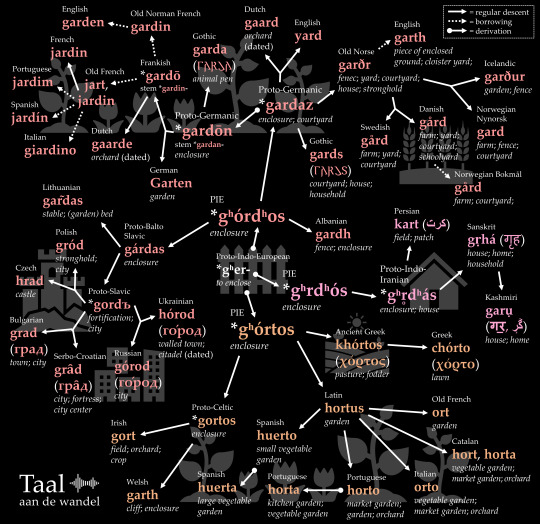
The words yard, garden and garth all stem from one and the same Germanic word. Yard is the native English form, garden took a detour via Old French, and garth was borrowed from Old Norse. These words are also distantly related to Latin hortus (garden), Russian górod (city) and Irish gort (field). Here's more.
#linguistics#historical linguistics#language#etymology#english#latin#french#dutch#german#semantics#proto-indo-european#proto-germanic#proto-balto-slavic#proto-slavic#ancient greek#spanish#portuguese#italian#catalan#irish#welsh#bulgarian#czech#lithuanian#polish#ukrainian#russian#proto-indo-iranian#persian#sanskrit
215 notes
·
View notes
Text
Tamil Linguistics thread (bc nobody cares but me)
but really, if you are interested in linguistics at all, give this post a read, because this shit really blew my mind ...
have been reading the following paper: https://ccat.sas.upenn.edu/~haroldfs/public/h_sch_9a.pdf
"The Tamil Case System" (2003) written by Harold F. Schiffman, Professor Emeritus of Dravidian Linguistics and Culture, University of Pennsylvania
Tamil is one of the oldest continuously-spoken languages in the world, dating back to at least 500 BCE, with nearly 80 million native speakers in South India and elsewhere, and possessed of several interesting characteristics:
a non-Indo-European language family (the Dravidian languages, which include other languages in South India - Malayalam being the most closely related major language - and one in Pakistan)
through the above, speculative ties to the Indus Valley Civilization, one of the first major human civilizations (you can read more about that here)
an agglutinative language, similar to German and others (so while German has Unabhängigkeitserklärungen, and Finnish has istahtaisinkohankaan, in Tamil you can say pōkamuṭiyātavarkaḷukkāka - "for the sake of those who cannot go")
an exclusively head-final language, like Japanese - the main element of a sentence always coming at the end.
a high degree of diglossia between its spoken variant (ST) and formal/literary variant (LT)
cool retroflex consonants (including the retroflex plosives ʈ and ɖ) and a variety of liquid consonants (three L's, two R's)
and a complex case system, similar to Latin, Finnish, or Russian. German has 4 cases, Russian has at least 6, Latin has 6-7, Finnish has 15, and Tamil has... well, that's the focus of Dr. Schiffman's paper.
per most scholars, Tamil has 7-8 cases - coincidentally the same number as Sanskrit. The French wikipedia page for "Tamoul" has 7:
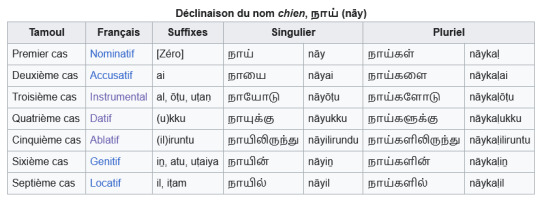
Dr. Schiffman quotes another scholar (Arden 1942) giving 8 cases for modern LT, as in common in "native and missionary grammars", i.e. those written by native Tamil speakers or Christian missionaries. It's the list from above, plus the Vocative case (which is used to address people, think of the KJV Bible's O ye of little faith! for an English vocative)
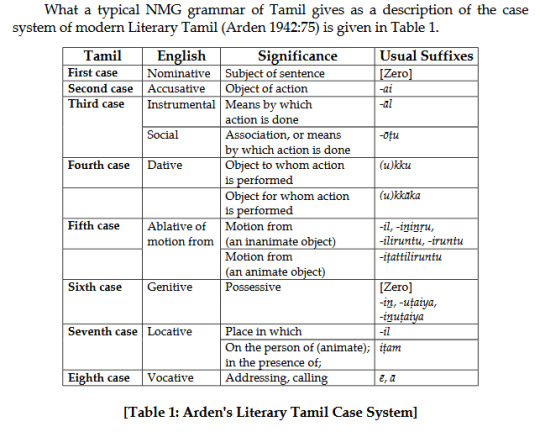
... but hold on, the English wiki for "Tamil grammar" has 10 cases:
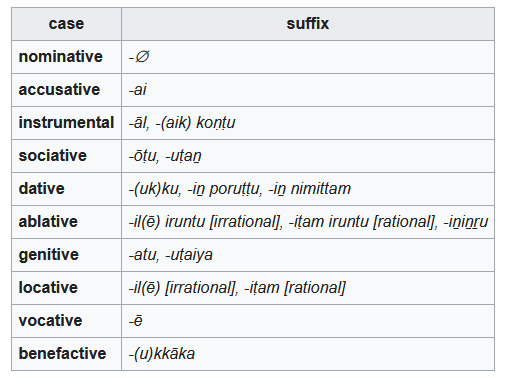
OK, so each page adds a few more. But hold on, why are there multiple suffix entries for each case? Why would you use -otu vs. -utan, or -il vs -ininru vs -ilirintu? How many cases are there actually?
Dr. Schiffman explains why it isn't that easy:
The problem with such a rigid classification is that it fails in a number of important ways ... it is neither an accurate description of the number and shape of the morphemes involved in the system, nor of the syntactic behavior of those morphemes ... It is based on an assumption that there is a clear and unerring way to distinguish between case and postpositional morphemes in the language, when in fact there is no clear distinction.
In other words, Tamil being an agglutinative language, you can stick a bunch of different sounds onto the end of a word, each shifting the meaning, and there is no clear way to call some of those sounds "cases" and other sounds "postpositions".
Schiffman asserts that this system of 7-8 cases was originally developed for Sanskrit (the literary language of North Indian civilizations, of similar antiquity to Tamil, and the liturgical language of Vedic Hinduism) but then tacked onto Tamil post-facto, despite the languages being from completely different families with different grammars.

Schiffman goes through a variety of examples of the incoherence of this model, one of my favorites quoted from Arden 1942 again:

There is no rule as to which ending should be used ... Westerners are apt to use the wrong one. There are no rules but you can still break the rules. Make it make sense!!
Instead of sticking to this system of 7-8 cases which fails the slightest scrutiny, Dr. Schiffman instead proposes that we throw out the whole system and consider every single postposition in the language as a potential case ending:
Having made the claim that there is no clear cut distinction between case and postpositions in Tamil except for the criterion of bound vs. unbound morphology, we are forced to examine all the postpositions as possible candidates for membership in the system. Actually this is probably going too far in the other direction ... since then almost any verb in the language can be advanced to candidacy as a postposition. [!!]
What Schiffman does next is really cool, from a language nerd point of view. He sorts through the various postpositions of the language, and for each area of divergence, uses his understanding of LT and ST to attempt to describe what shades of meaning are being connoted by each suffix. I wouldn't blame you for skipping through this but it is pretty interesting to see him try to figure out the rules behind something that (eg. per Arden 1942) has "no rule".


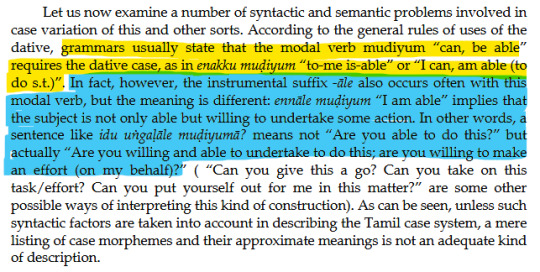
On the "extended dative", which connotates something like "on the behalf of" or "for the sake of":
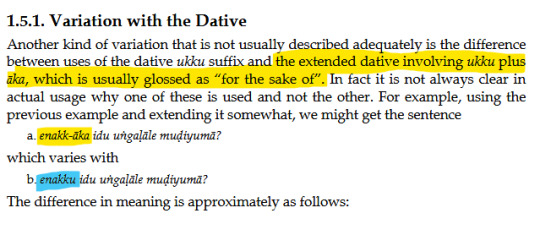

I especially find his analysis of the suffix -kitte fascinating, because Schiffman uncovers a potential case ending in Spoken Tamil that connotes something about the directness or indirectness of an action, separate from the politeness with which the person is speaking to their interlocutor.

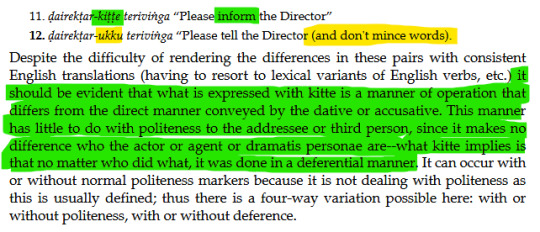
Not to blather on but here's a direct comparison with Finnish, which as stated earlier has 15 cases and not the 7-8 commonly stated of Tamil:
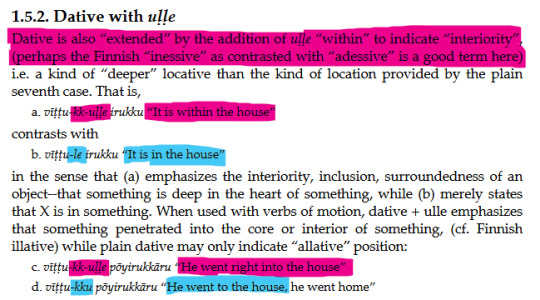
What Schiffman seems to have discovered is that ST, and LT too for that matter, has used existing case endings and in some cases seemingly invented new ones to connote shades of meaning that are lost by the conventional scholar's understanding of Tamil cases. And rather than land on a specific number of cases, he instead says the following, which I find a fascinating concept:
The Tamil Case System is a kind of continuum or polarity, with the “true” case-like morphemes found at one end of the continuum, with less case-like but still bound morphemes next, followed by the commonly recognized postpositions, then finally nominal and verbal expressions that are synonymous with postpositions but not usually recognized as such at the other extreme. This results in a kind of “dendritic” system, with most, but not all, 8 of the basic case nodes capable of being extended in various directions, sometimes overlapping with others, to produce a thicket of branches. The overlap, of course, results from the fact that some postpositions can occur after more than one case, usually with a slight difference in meaning, so that an either-or taxonomy simply does not capture the whole picture.
How many cases does Tamil have? As many as its speakers want, I guess.
93 notes
·
View notes
Text
What is a Russian Character and How to write them
As @sarapaprikas-blog and I were working on this post, we noticed a gap of knowledge and public perception that we want to address. Plenty of characters get labelled as Russian in media without necessarily being Russian. On the other hand the Archetypal ”Russian” character often does not mirror the realities of being Russian. We are to talk about that.
What is Russia?
Russia is a country. It is the largest country in the world with over 140 million inhabitants, stretching over 11 time zones. It is often seen as the successor state to the Soviet Union, which in itself was the successor state of the Russian Empire. The Soviet Union and Russia do not have the same borders or government. However, modern Russia draws a lot from its history as the largest and dominant part of the Soviet Union. Before the Soviet Union, the area was governed by the Russian Empire. The Russian Empire, as the name already indicates, was imperialist. The history as an Empire with massive expansion, colonies and conquering different people, is arguably the biggest reason why modern Russia is as big as it is today.
What is Russian?
There is a difference between the language Russian, the ethnicity Russian, and the nationality Russian. In English the difference can be made out only by context.
Who is Russian?
As aforementioned, there is a difference between Russian (Россиянин) meaning citizen of Russia, and ethnically Russian (Русские). The term Russian (Русские) usually refers to ethnicity, indicating a person who has Russian roots. Russian (Россиянин) implies Russian citizenship, regardless of ethnicity. Thus, a Russian can be someone with Russian citizenship, but not all Russian citizens are Russians in the ethnic sense. Also, not all ethnic Russians have Russian citizenship or live within Russia.
Ethnic-Russians are an East Slavic people. Obviously, they mainly live in Russia. But there are also large communities in Ukraine, Kazakhstan, Belarus, Latvia, Lithuania, and other countries. The traditional religion among Russians is Orthodox Christianity. The main language is Russian.
The country Russia is home to more than 190 ethnicities, including indigenous and autochthonous people, leading to a variety of languages, religions and practiced cultures. So, someone who holds a Russian citizenship, has ethnic Russian heritage and / or speaks Russian, can look very different than the cliche Russian bond girl or evil-doer indicates. That also means that those who get labelled Russian can live very different lives. Writing a Russian character gives you a lot of room outside of the prevalent stereotyped depictions.
Who is not Russian?
Simple - those who say they are not Russian, are not Russian.
Who are Slavs? What is Slavic?
The slavic people are a variety of people, ethnically Russian people are part of that group. However, there are a lot of other ethnic groups that are Slavs without being Russian e.g. Poles, Sorbs, Czech, Ukrainians, and many more. Slavic is the corresponding adjective to Slavs. It is often used to describe the indo-Slavic language group. Slavic is also often used to describe the collectively perceived similarities of Slavic peoples' culture. However, that can be misleading and get’s often orientalised as not everything from Eastern-Europe or Russia is slavic.
Russian vocabulary Да - Yes Нет - No Привет - Hi Здравствуйте - Hello Как дела ? - How are you? Хорошо - Good Пожалуйста - Please Не за что - my pleasure До свидания - Goodbye Пока - bye Увидимся - See you later Хорошего дня - Have a nice day Простите - I'm sorry. (Plural or honoured addressee) Помогите, пожалуйста. - Help me please. (Plural or honoured addressee) Доброе утро - Good morning Доброй ночи - Good night. Добрый день - Good day / afternoon.
Pet names in Russian About pet names. They are either masculine of feminine . Please don't use words like darling, kitten, baby, pretty, sweetie, little one, little fox, etc. as they sound really strange in translation to native speakers. Pet names are common for close ones (family, close friends, spouses). Sometimes primary school teachers call students by affectionate names. Also sweet old lady may call you ( Дорогой/ Дорогая). But outside of that nobody calls each other by pet names, only using names because Russians are very reserved and private people in general. Gender neutral pet names: жизнь моя - my life солнце мое - my sun or my sunshine ты мое все - you my everything. лучик - sunray. мое сокровище - my treasure. мое золотце - my gold or sweetheart. моя любовь - my love. ты моя радость - you are my joy. ангелочек - Angel. прелесть моя - my precious.
Queerness and gender-neutral speech in Russian Being queer in Russia is hard as queers face oppression. Because of that, there is limited to no public discourse on how to adapt and diversify the language to include queer and especially non-binary identities. This is a problem as the Russian language is extremely gendered and expresses a gender binary in near default. While gender neutral pronouns in Russian exist, it's harder to use them in real life as the neutral pronoun “оно” is mostly associated with things or animals and not living humans, similar to the English “it”. Often words generally do not have gender neutral alternatives. However, one way we suggest for a more gender neutral speech is to avoid most explicit gendering as the flexible syntax in combination with using plural pronouns in Russian allow for more gender neutral speech. For Example: Я люблю их всем моих сердцем - I love them with all my heart. Расскажи мне о них! - Tell me about them. Дай им время- give them time. Я горжусь ими - I'm proud of them. Они сделает это сами - they do it themselves. Read more about queerness in Russia here: one two three four
Russian swearing In Russia, swearing is considered a sign of rudeness and poor manners. Use accordingly. Also, as mentioned here, Russian syntax and inflection are different from English. Meaning one word can be a whole sentence. We punctuated every swearing that is technically a whole sentence and therefore can stand on its own grammatically. Блять - fuck Пошел нахуй. - fuck you Хуй - dick Пизда - cunt Мы в пизде. - we are fucked / “We are stuck in the cunt.” Ебать - fuck Ахуел. - are you/they crazy?! Это пиздец. - this fucked up Мудак - asshole Завали ебало. - shut the fuck up Сука - bitch Черт - damn Непизди. - stop fucking lying. / Cut your bullshit. Пиздобол - Person who lies a lot/ Don't lie Мамку твою ебал. - i fucked your mom (mostly used by middle schoolers, here in grammatically masculine gender.) Заебись. - holy shit (could be bad or good depend on situation) Похуй! - I don't fucking care. ��авешать пиздюлей - to beat up someone. Срать тебе в рот - To crap in your mouth. Ты ебанулся. - Are you batshit crazy. Заебал. - I'm sick of you. Жопа - ass. Иди в баню. - soft version of Иди нахуй.
Explanation of the Russian Naming System & Patronyms
The Russian naming system consists of three main elements: first name, patronymic and last name. Name: This is the first name given to a child at birth. In Russia, the names are chosen by the parents or relatives of the child. Names can be both traditional (Alexander, Anna, Ekaterina) and modern (Sofia, Victoria, Yaroslav). Patronymic: this is the second name, which reflects the child's origin from his father. Some cultures in Russia also use the mothers name. The patronymic name among Russian people arose in the 10th - 11th centuries and was used infrequently at first, but became widespread around the 16th century. It is formed by adding the suffix "-ovich" or "-aries" to the father's name. For example, if the father's name is Ivan, then his child Ivan or Ivanna will be called Ivan Ivanovich or Ivanna Ivanovna. Last name: This is a family surname that is passed down from generation to generation. It is usually assigned at birth and does not change without special circumstances. Surnames can come from various sources, such as profession, place of residence, origin, or personal characteristics. As a result, a person's full name consists of a first name, a patronymic (if applicable) and a last name, for example: Ivan Ivanovich Petrov.
How to respectfully address a person in Russian. In Russian there are two ways to address someone. Using the polite you (Вы) amd using the formal you (Ты). The choice of mode depends on how well you know the other person and whether you are superior or inferior in terms of age and social position. If you know the person's first name you refer to them by first name and patronymic. For examples: Борис Юрьевич, Ваши рабочие отлично справились с ремонтом- Boris Yurievich, your workers did a great job with repairs. Adults never address a person by name, only by surname or patronymic unless the addressee gives permission to address them in an informal manner. Regulations of most military require their members address each other in formal you( Вы ); subordinates address commanders as товарищ (comrade) + rank , while higher ups address subordinates by military rank and surname. Example: [Colonel to Sgt. Sidorov] Сержант Сидоров, ко мне! Sergeant Sidorov, front and center! [sgt. Sidorov to colonel] По вашему приказанию прибыл, товарищ полковник! Reporting for duty [lit. arrived at your (pl.) request], comrade colonel! Military men sometimes use same forms of address, albeit in singular, in friendly conversation. Example: Сержант, дай сигарету. - Give (sing.) me a cigarette, Sarge. Military hierarchy in Russia You can find useful links here. One Two
#könig#sarapaprikasblog#nikto#call of duty 3#call of duty modern warfare 3#creative writing#nik cod#nikolai belinski#cod#cod modern warfare#gromsko#call of duty#gromsko cod#sobiesław kościuszko#grimmwriting#sebastian krueger
343 notes
·
View notes